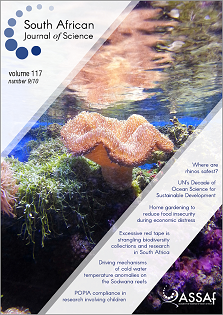Model inter-comparison for short-range forecasts over the southern African domain
DOI:
https://doi.org/10.17159/sajs.2021/8581Keywords:
numerical weather prediction models, convective scale, physical process, model inter-comparison, South African Weather ServiceAbstract
Numerical weather prediction (NWP) models have been increasing in skill and their capability to simulate weather systems and provide valuable information at convective scales has improved in recent years. Much effort has been put into developing NWP models across the globe. Representation of physical processes is one of the critical issues in NWP, and it differs from one model to another. We investigated the performance of three regional NWP models used by the South African Weather Service over southern Africa, to identify the model that produces the best deterministic forecasts for the study domain. The three models – Unified Model (UM), Consortium for Small-scale Modelling (COSMO) and Weather Research and Forecasting (WRF) – were run at a horizontal grid spacing of about 4.4 km. Model forecasts for precipitation, 2-m temperature, and wind speed were verified against different observations. Snow was evaluated against reported snow records. Both the temporal and spatial verification of the model forecasts showed that the three models are comparable, with slight variations. Temperature and wind speed forecasts were similar for the three different models. Accumulated precipitation was mostly similar, except where WRF captured small rainfall amounts from a coastal low, while it over-estimated rainfall over the ocean. The UM showed a bubble-like shape towards the tropics, while COSMO cut-off part of the rainfall band that extended from the tropics to the sub-tropics. The COSMO and WRF models simulated a larger spatial coverage of precipitation than UM and snow-report records.
Significance:
- Extreme weather events, such as tornadoes, floods, strong winds and heat waves, have significant impacts on society, the economy, infrastructure, agriculture and many other sectors. These impacts may be mitigated or even prevented through early warning systems which depend on the use of weather forecasts and information from NWP models. As South Africa depends on models from developed countries, these models may have shortcomings in capturing extreme weather events over the southern African region.
Published
Issue
Section
License

This work is licensed under a Creative Commons Attribution 4.0 International License.

All articles are published under a Creative Commons Attribution 4.0 International Licence
Copyright is retained by the authors. Readers are welcome to reproduce, share and adapt the content without permission provided the source is attributed.
Disclaimer: The publisher and editors accept no responsibility for statements made by the authors
How to Cite
- Abstract 769
- PDF 686
- EPUB 176
- XML 166
Funding data
-
African Academy of Sciences
Grant numbers CR4D-19-11












.png)